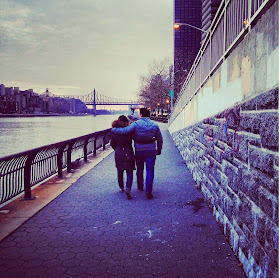Like many urbanites starting out in New York, I rent a small studio that can fit a bed, a desk, a bike and a kitchen fit for one person. My laundry room is down the block and my pantry is on the opposite street corner. I have a library in the East Village and a gym in Midtown. The city is my living room and the streets between my activities are corridors with windows into other private realms. A vast proportion of the urban fabric is a transient space. The forces that shaped these spaces – namely, the trajectory of the automobile - are becoming less influential and a new spatial network is emerging at a rapid pace. In the overlap with my neighbor and my own distributed dwelling patterns, there could exist radical new living spaces for a generation of people enjoying people (on a budget).
Envision an innovative spatial network and new kind of housing called Bitroom. This
decentralized concept of living has many spaces that can be dispersed in the city based on activity and interaction. The idea proposes a series of open-source environments that are influenced by many users and offer temporary benefit to the individual. In this model, the core dwelling functions like sleeping and washing remain private spaces with a permanent address (where soap is delivered), but all other Bitrooms are made available collectively by the network.
Think of Bitroom as a dynamic peer-to-peer exchange of living space on a daily timeframe.
Imagine having a drawing studio downtown, a gaming room on the west side, or a BYOB lounge in Brooklyn. The cost to have all of these rooms in one Manhattan dwelling would be so excessive and eliminate social pollination in an age when collecting attention has come to be valued over privacy. These circumstances point to a new common territory for the urban demographic that operate between couch surfing and time-share ownership. Through Bitroom, the apparatus of ownership is questioned and space assumes its own value as a trading device in the system.
Semi-public urban amenities like cafes, bars, and theaters require financial exchange in order to engage with these shared environments; one must make a monetary contribution by buying a coffee, a beer or ticket. This financial obligation sets up an economic barrier for the expansion of living beyond the private realm. The decoupling of spaces for trading (retail) from the trading of spaces (living) has the potential to transform the physical city. This would require spaces to be carved out of the city in existing buildings or reclaiming the public right-of-way.
The terms of operation could be modeled after a distributed consensus system in which the
rooms are open and free for all users willing to partake. Bitrooms could be accessed through a mining process that unpacks access to them from the urban block. This idea of “mining” creates the equivalent of a competitive lottery that prevents any individual from monopolizing one space and cultivates vested users. Rather than exchanging money, an exchange of space itself occurs through a virtual “check-in” to one room, which releases the unused blocks back into the network for others to access. A maximum occupancy is set for each room and as this limit is reached other rooms become active. Over time, a high demand for Bitrooms triggers further mining, until a robust web populates the urban fabric.
A spatial network like this proposition may take shape in underused pieces of primary urban
localities. The off-street parking space has often eluded urban usefulness in a post automobile-centric era but has been reimagined on the West Coast. The “Parklet” program repurposes this zone into open public space sponsored by neighboring businesses. It is a remarkable mechanism of increasing communal space accessible to all while reflecting the diversity of those who modify it. This remarkable concept has taken leaps and bounds on implementing shared resources, however it stays at the level of the streetscape. The idea of Bitroom could introduce common territories beyond the urban park or plaza by responding to a new architectural typology that provokes the role of the city and the shrinking dimensions of urban housing.
The future city will increasingly demand newcomers like me to pay more for less private space. The trade-off is proximity to cultural conveniences but that also costs more money. This trend, combined with the de-emphasis on privacy in the era of status updates and geo-located check-ins, sets up a structure for a new kind of housing. The inefficiencies built into the urban fabric are leftover from organizing principals of past regimes. Bitroom is an ideal living configuration that changes with the days of the week and each user puts a personal stamp on the environment. Basic human needs anchor dwellers to a bed at night but every movement in between could reshape the environment. When I think of the city as a living room, my frame of mind shifts and I no longer see a separation of architectural objects but rather an occupation of connected space. Emerging living formations require a radical adaptation of the physical city where shareholding materializes through decentralized spatial assets.
By
Rosannah Sandoval, R.A.
